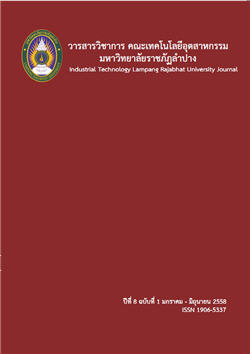ระบบเทคโนโลยีภูมิสารสนเทศเพื่อการจัดการที่ดินโดยชุมชน และการใช้ประโยชน์ที่ดินในพื้นที่ปลูกพืชเศรษฐกิจ เขตองค์การบริหารส่วนตำบลแม่พูล อำเภอลับแล จังหวัดอุตรดิตถ์
DOI:
https://doi.org/10.14456/itjlp.2015.9Keywords:
ระบบเทคโนโลยีภูมิสารสนเทศ, ระบบภูมิสารสนเทศออนไลน์, การจัดการที่ดินโดยชุมชน, Geo-informatics Technology Systems, Geo-informatics Online, Land management by communitiesAbstract
การวิจัยครั้งนี้มีวัตถุประสงค์ 2 ประการ คือ 1) เพื่อประยุกต์เทคโนโลยีภูมิสารสนเทศมาใช้เป็นเทคโนโลยีที่ชุมชนสามารถจัดทำหรือปรับปรุงข้อมูลเกี่ยวกับการจัดการที่ดินและการใช้ประโยชน์ที่ดินระดับแปลงและนำไปสู่กระบวนการจัดการที่ดินของชุมชนได้เอง 2) เพื่อสร้างกลไก กติกาและหลักเกณฑ์ปฏิบัติร่วมกันและนำไปใช้เป็นต้นแบบของการจัดการที่ดินที่ยั่งยืน
วิธีการวิจัยมีการเลือกพื้นที่ศึกษาแบบจำเพาะเจาะจงพื้นที่ 11 หมู่บ้าน ตำบลแม่พูล อำเภอ ลับแล จังหวัดอุตรดิตถ์ การรวบรวมข้อมูลใช้วิธีการสังเกตการณ์แบบมีส่วนร่วม การสนทนาเฉพาะกลุ่ม การสัมภาษณ์เชิงลึกจากกลุ่มประชากรตัวอย่างที่เฉพาะเจาะจงซึ่งเป็นผู้มีส่วนได้ส่วนเสียทั้งหมดในพื้นที่ 3 กลุ่ม ได้แก่ 1) กลุ่มประชากรในพื้นที่ 2) หน่วยงานภาครัฐ และ 3) กลุ่มนักพัฒนา และนักวิชาการที่มีความรู้และประสบการณ์เกี่ยวกับการจัดการที่ดิน การสำรวจภาคสนามโดยใช้เครื่องกำหนดพิกัดบนพื้นผิวโลก การแปลและตีความภาพถ่ายดาวเทียม GeoEye-1 บันทึกเมื่อวันที่ 16 มกราคม 2556 รายละเอียดจุดภาพ 0.5 เมตร แบบบันทึกภาคสนาม แบบสอบถาม เพื่อจัดทำแผนที่การใช้ประโยชน์ที่ดินปี พ.ศ. 2556 และระบบภูมิสารสนเทศออนไลน์สำหรับการจัดการที่ดิน
ผลการจำแนกการใช้ประโยชน์ที่ดิน พบว่าเขตองค์การบริหารส่วนตำบลแม่พูลมีพื้นที่82,522.30 ไร่ ส่วนใหญ่ใช้ในการเพาะปลูกพืชเศรษฐกิจได้แก่ ทุเรียน ลางสาด และลองกองคิดเป็นร้อยละ 56.42 จำแนกเป็น 7 ประเภท ดังนี้ 1) ทุเรียน 36,333.10 ไร่ (ร้อยละ 44.03) 2) ป่าเบญจพรรณผสมป่าไผ่ 31,917.70 ไร่ (ร้อยละ 38.68) 3) ลองกองและลางสาด 10,225.25 ไร่ (ร้อยละ 12.39) 4) ที่อยู่อาศัย 2,871.17 ไร่ (ร้อยละ 3.48) 5) หอมและนาข้าว 602.03 ไร่ (ร้อยละ 0.73) 6) ป่าเสื่อมโทรมถูกแผ้วถาง 394.46 ไร่ (ร้อยละ 0.48) และ 7) แหล่งน้ำ 178.59 ไร่ (ร้อยละ 0.22) และข้อมูลภูมิสารสนเทศสามารถนำไปใช้สำหรับการจัดการที่ดินผ่านระบบภูมิสารสนเทศออนไลน์ โดยใช้ข้อมูลเชิงบรรยายเชื่อมโยงกับข้อมูลที่ดินรายแปลงกลไก กติกาและหลักเกณฑ์ปฏิบัติร่วมกัน เพื่อเป็นต้นแบบในการจัดการที่ดินในเขตป่าไม้ถาวรและเขตป่าสงวนแห่งชาตินั้น สามารถสรุปเป็นบันได 7 ขั้นแห่งความสำเร็จของต้นแบบการจัดการที่ดินในพื้นที่ป่าไม้แบบยั่งยืนได้แก่ 1) การป้องกันการบุกรุกป่าเพิ่มเติม 2) การป้องกันการ แผ้วถางพื้นที่ป่าไม้ 3) การอนุรักษ์ป่าไม้ 4) การจัดทำฐานข้อมูลการใช้พื้นที่ 5) การป้องกันการเข้ามาใช้พื้นที่ของนายทุน 6) การป้องกันการตัดต้นไม้ใหญ่มากเกินไป และ 7) การใช้วิถีเกษตรยั่งยืน และได้นำต้นแบบดังกล่าวไปปรับใช้ในพื้นที่ ที่มีบริบทใกล้เคียงอีก 3 ตำบล ได้แก่ตำบลนานกกก ตำบลบ้านด่านนาขาม และตำบลขุนฝาง
The use of Geo-informatics Systems for Improved Land Management in Maepoon subdistrict, Uttaradit.
The objectives of the research were: 1) To use geo-informatics technology to help local people manage and improve information relating to land-management and to use this to improve land management themselves and 2) to develop mechanisms and regulations regarding sustainable land use and to use these as a model for others.
The research methodology used in this research was purposive selection in 11 villages in and around Maepoon, Lablae district, Uttaradit province. Data were collected by participant observation, focus groups and in-depth interviews with stakeholders from three groups; local people, government personnel, and academics/experts.
The field survey used GPS, interpreted from high resolution satellite images (Geo-Eye with 0.5 meter resolution recorded on January 16, 2013), field books, questionnaires, maps showing land use in 2013, and online geo-informatics.
In Maepoon subdistrict, 82,522.30 rai were used for planting commercial crops such as durian, longong, and langsad. This was 56.42% of the total. Land use can be divided into 7 classes: durian (44.03%), mixed forest and bamboo (38.68%), longong and langsad (12.39%), residential (3.48%), shallot and rice (0.73%), slash and burn (0.48%), and water resources (0.22%). Geo-informatics data can be used to manage land use in conjunction with online information management with geo-informatics online. The system links data to describe in detail the land use in the area.
The mechanisms and regulations for managing land use in permanent forest and national forest reservations can be a model for managing land in other subdistricts. These can be summarized as: prevent trespassing in forests, protect forest reclamation, conserve existing forests, build a land use database, prevent large-scale commercial exploitation of forest areas, prevent logging of large trees, and use sustainable agricultural methods.






